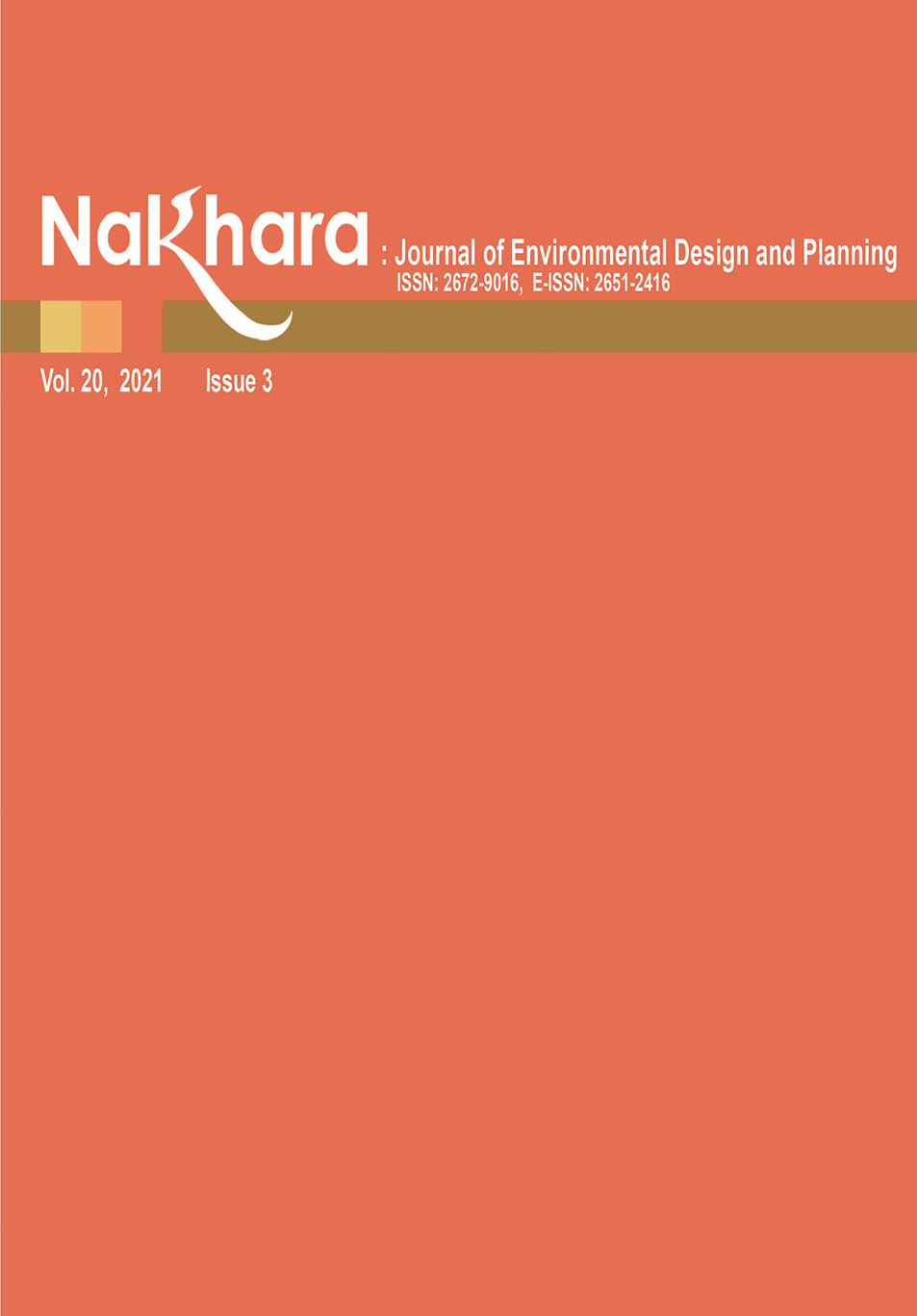The Urban Image Conservation and Development of Nakhon Si Thammarat’s Old Town Community in Thailand
Main Article Content
Abstract
Nakhon Si Thammarat Old Town Community dated a thousand years old from four eras of settlement development. The community is located on an ancient beach ridge that stands until the present day. It also has an image of a community that is unique to any city. Today the community is rapidly expanding, so the importance of the old town’s various elements has been diminished. The research objectives are to analyze Nakhon Si Thammarat Old Town Community’s image and landscape and provide suggestions to preserve and develop the community’s image. The methodology is theoretical concepts of the image of the city, urban landscape, historic urban landscape, and urban conservation, including field surveys to identify problems and the community’s awareness. Visual assessments and mapping were also undertaken. Based on the study, the urban conceptual framework emphasizes the five elements of physical perception, whereas the cultural landscape concept focuses on the physical perception of the community’s core components and sub-elements that express specificity of the district, including traditional custom, which is intangible culture and a landscape element as well.
The analysis of urban image reveals that Nakhon Si Thammarat Old Town Community consists of the path in the area with Ratchadamnoen Road, Karom Road and Pattanakarn Khukwang Road as the main routes, the edge of the community divided by natural boundaries, which are various rivers and by man-made boundaries, which are canals and the old city’s embankments, and the unique district, such as Tha Wang Community, Khaek Market Community, and Nakhon Si Thammarat Old Town. The node or activity center is, for example, business activities in Tha Wang Community, Khaek Market Community and Hua It Market Community, and the tourism activities in the old community area around Phra Mahathat Woramahawihan Temple. The prominent landmark from the past to the present is Phra Borommathat Stupda. In addition, the unique physical elements in the old town are groups of large trees. Suggestions on conservation and development are to create awareness of secondary routes to reduce congestion of the main roads and connect to other attractions; to develop the old town’s border from four eras for clearer perception; to promote the main activities within each district; and to have measures to control the height, billboards, old buildings’ styles, and new buildings representing each district’s uniqueness that will not obscure the perception of the community’s landmarks.
Article Details

This work is licensed under a Creative Commons Attribution-NonCommercial-NoDerivatives 4.0 International License.
References
Chumphengphan, P. (2012). mư̄ang nakhō̜n sī tham rāt mahā nakhō̜n [Nakhon Si Thammarat, the metropolis]. Duankamon.
Chuvichean, P. (2010). phra bō̜rommathāt čhēdī nakhō̜n sī tham rāt mahā sathūp hǣng khāpsamut phāk tai [Phra Borammathat Chedi Nakhon Si Thammarat, the great stupa of the Southern Peninsula]. Muang Boran Press.
Cullen, G. (1995). The Concise Townscape. Butterworth-Heinemann.
Duxbury, N., Hosagrahar, J. & Pascual, J. (2016). Why must culture be at the heart of sustainable urban development?. http://www.agenda21culture.net/sites/default/files/files/documents/en/culture_sd_cities_web.pdf
Ginzarly, M., Houbart, C., & Teller, J. (2019). The historic urban landscape approach to urban management: A systematic review. International Journal of Heritage Studies, 25(10), 999–1019. https://doi.org/10.1080/13527258.2018.1552615
Global Observatory on the Historic Urban Landscape. (2016). The HUL guidebook: Managing heritage in dynamic and constantly changing urban environment. https://gohulsite.files.wordpress.com/2016/10/wirey5prpznidqx.pdf
Green, R. (1999). Meaning and form in community perception of town character. Journal of Environmental Psychology, 19(4), 311–329. https://doi.org/10.1006/jevp.1999.0143
The Interational Council on Monuments and Sites (ICOMOS). (1987). Charter on the Conservation of Historic Towns and Urban Areas. 8th General Assembly. October1987, Washington, DC.
Issarathumnoon, W. (2020). Applying the historic urban landscape approach to the identification of urban heritage attributes of Bangkok old town. Nakhara: Journal of Environmental Design and Planning, 19, 25–38.
Khanjanusthiti, P. (2009). kānʻanurak mō̜radok sathāpattayakam læ chumchon [Architectural and local heritage conservation]. Chulalongkorn University Press.
Lynch, K. (1960). The image of the city (Nachdr.). MIT PRESS.
Nakhon Si Thammarat Municipality. (1995). rư̄ang kamnot bō̜riwēn hām kō̜sāng datplǣng ʻākhān bāng praphēt nai bō̜riwēn khēt phư̄nthī mư̄ang kao Phō̜.Sō̜. 2538 [Identification of areas with no construction and renovation of certain buildings in the Old Town 1995]. Nakhon Si Thammarat Municipality.
Nakhon Si Thammarat Provincial Public Works and Town Country Planning Office. (2019). phangmư̄ang rūam nakhō̜n sī tham rāt [Complete Nakhon Si Thammarat city planning]. Nakhon Si Thammarat.
Office of Natural Resources and Environmental Policy and Planning. (2010). prakāt khēt mư̄ang kāonakhō̜n sīthammarāt [Annoucement of Nakhon Si Thammarat Old Town area]. https://tinyurl.com/yckwf6kx
Peerapun, W., Sereerat, S., Sanit, P., & Vichienpradit, P. (2020). Master planning for conservation and development of Krung Rattanakosin 2032. Nakhara: Journal of Environmental Design and Planning, 19, 39–58.
Qviström, M., & Vicenzotti, V. (2016). Landscape research in landscape research: Reflections on a changing field. Landscape Research, 41(4), 385–387. https://doi.org/10.1080/01426397.2016.1165409
Rodwell, D. (2018). The historic urban landscape and the geography of urban heritage. The Historic Environment: Policy & Practice, 9(3–4), 180–206. https://doi.org/10.1080/17567505.2018.1517140
The International Committee on Historic Towns and Villages. (2011). The Valletta Principles for the Safeguarding and Management of Historic Cities, Towns and Urban Areas. The 17th ICOMOS General Assembly. Paris: ICOMOS.
The United Nations Educational, Scientific and Cultural Organization (UNESCO). (2008). World heritage information kit. http://whc.unesco.org/documents/publi_infokit_en.pdf
The United Nations Educational, Scientific and Cultural Organization (UNESCO). (2011). Recommendation on the historic urban landscape. https://whc.unesco.org/uploads/activities/documents/activity-638-98.pdf
The United Nations Educational, Scientific and Cultural Organization (UNESCO). (2015). Culture for sustainable development initiative. http://www.unesco.org/new/en/culture/themes/culture-and-development/culture-for-sustainable-urban-development/

